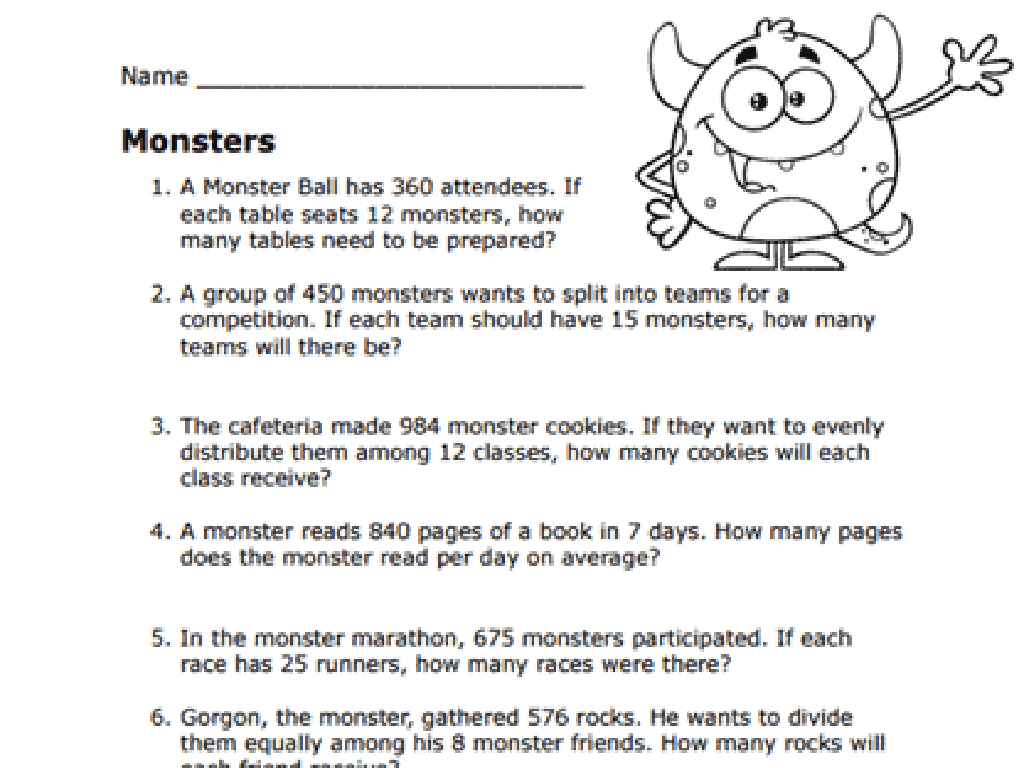Find Equivalent Fractions Using Number Lines
Subject: Math
Grade: Third grade
Topic: Equivalent Fractions
Please LOG IN to download the presentation. Access is available to registered users only.
View More Content
Welcome to Equivalent Fractions!
– What is a fraction?
– A fraction represents a part of a whole.
– Exploring equivalent fractions
– Fractions that represent the same value.
– Using number lines for fractions
– A tool to visualize fractions and their equivalents.
– Today’s goal: find equivalent fractions
|
Begin the lesson by explaining the basic concept of a fraction as a part of a whole, using simple examples like a pizza cut into slices. Then, introduce the concept of equivalent fractions by showing different fractions that represent the same amount, such as 1/2 and 2/4. Use a number line on the board to demonstrate how to find equivalent fractions by dividing the line into different numbers of equal parts. Today’s goal is for students to understand and find equivalent fractions using number lines. Encourage students to draw their own number lines and practice finding equivalent fractions for given examples. Provide guidance and support as they explore this concept.
Understanding Fractions
– A fraction shows part of a whole
– Top number is the numerator
– It tells us how many parts we have
– Bottom number is the denominator
– It tells us into how many parts the whole is divided
– Example: 1/2 of a pizza
– If a pizza is cut into 2 pieces, 1/2 means we have one of those pieces
|
This slide introduces the concept of fractions to third-grade students. A fraction is explained as a way to represent a part of a whole, with the numerator indicating the number of parts taken and the denominator showing the total number of equal parts the whole is divided into. Use the example of a pizza cut into two equal parts to illustrate this concept, as it is relatable and easy to visualize. Emphasize that the numerator and denominator are parts of a fraction and each has a specific role. Encourage students to think of other examples of halves in their daily life to solidify their understanding.
Exploring Number Lines with Fractions
– What is a number line?
– A straight line with numbers at equal spaces
– Fractions on a number line
– Fractions have their own place on the line
– Each point is a unique fraction
– Like addresses, each spot is different
– Equivalent fractions visually
– Same value fractions can be seen at different points
|
This slide introduces students to the concept of number lines and their use in identifying fractions. A number line is a visual representation where numbers are laid out at equal intervals along a straight line. It’s important for students to understand that every point on the line corresponds to a unique fraction, and that fractions can be represented visually on this line. By placing equivalent fractions on a number line, students can see how different fractions can represent the same value. For example, 1/2 is the same as 2/4 on a number line. Use this slide to prepare students for an activity where they will find and mark equivalent fractions on a number line.
Understanding Equivalent Fractions
– What are equivalent fractions?
– Fractions that represent the same amount
– Example: 1/2 equals 2/4
– Both fractions reduce to 1/2
– Equivalent fractions have equal value
– They may look different, but they’re the same size
– Visualizing with number lines
– Use number lines to compare fractions easily
|
This slide introduces the concept of equivalent fractions to third-grade students. Start by explaining that equivalent fractions are different ways of writing the same amount. Use simple examples like 1/2, 2/4, and 3/6 to show that although the numbers are different, the value they represent is the same. Emphasize that equivalent fractions are equal in value, even if they look different. Introduce number lines as a tool to help visualize and compare the size of different fractions, reinforcing the concept that they can be equivalent. Encourage students to draw their own number lines and plot different fractions to see which ones are equivalent.
Finding Equivalent Fractions on a Number Line
– Divide number line into equal parts
– Like cutting a cake into same-size pieces
– More divisions, more equivalents
– Each cut creates more slices, or fractions
– Example: 1/2 equals 2/4
– Show 1/2 and 2/4 on the line; they match!
– Practice with different fractions
– Try finding equivalents for 1/3 or 3/6
|
This slide introduces the concept of finding equivalent fractions using a number line. Start by explaining that dividing a number line into equal parts represents fractions. Emphasize that the more parts we divide the number line into, the more equivalent fractions we can find. Use the example of 1/2 and 2/4 to show how they represent the same point on the number line, demonstrating their equivalence. Encourage students to practice with different fractions, such as finding equivalents for 1/3 or 3/6, to reinforce the concept. Provide guidance on how to draw and label number lines for this purpose.
Activity: Draw Your Number Line
– Draw a line from 0 to 1
– Mark and label 1/2
– Divide 0 to 1/2 equally
– What fraction is halfway between 0 and 1/2?
– Find the equivalent fraction
– Is it the same as 1/2?
|
This activity is designed to help students visually understand equivalent fractions using a number line. Start by having them draw a number line from 0 to 1. Next, instruct them to mark the halfway point and label it as 1/2. Then, guide them to divide the first half of the number line into two equal parts, which will help them discover that 1/4 is equivalent to 2/4. Encourage students to think about other fractions that might be equivalent to 1/2. Provide assistance as needed and ensure that each student is able to identify and label the equivalent fractions correctly. For advanced students, challenge them to find fractions equivalent to 1/4 or 3/4.
Class Activity: Exploring Equivalent Fractions
– Pair up and use number lines
– Find equivalent fractions
– Look for fractions that mark the same point on the number line
– Share with the class
– Discuss why they’re equivalent
– Understand that they have the same value, even if they look different
|
This activity is designed to help students visually understand the concept of equivalent fractions using number lines. By working in pairs, students can collaborate to find fractions that represent the same point on a number line, reinforcing the idea that equivalent fractions are different fractions that represent the same value. After finding the fractions, students will engage with the class by sharing their findings, which promotes communication skills and allows for peer learning. The discussion part will solidify their understanding of the concept. As a teacher, prepare to guide them through the activity with examples like 1/2 is the same as 2/4 on the number line. Have additional number line handouts ready for students who may need them and prepare to offer support to pairs who might struggle with the concept.
Conclusion & Homework: Mastering Equivalent Fractions
– Excellent work on equivalent fractions!
– Practice finding more at home
– Complete the worksheet provided
– Use number lines to find fractions equal to those given
– Bring any questions to class
– We’ll review any challenges next time
|
Today’s class focused on understanding and finding equivalent fractions using number lines, an important skill in third-grade math. For homework, students are provided with a worksheet that reinforces this concept. Encourage them to practice at home to solidify their understanding. The worksheet includes a variety of problems that require students to use number lines to visually represent and find equivalent fractions. Remind students to bring any questions they have to the next class for clarification. This practice will help them become more confident in their ability to work with fractions.





